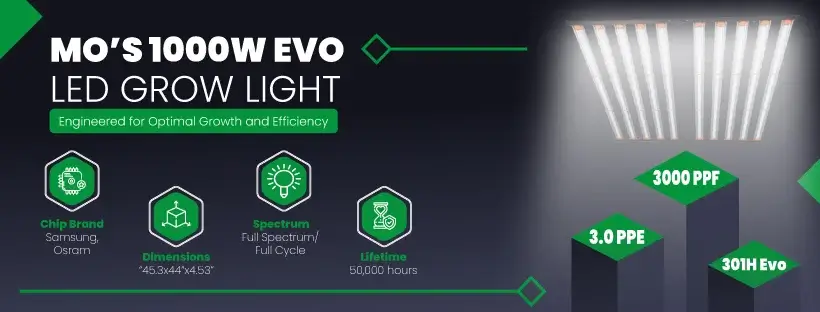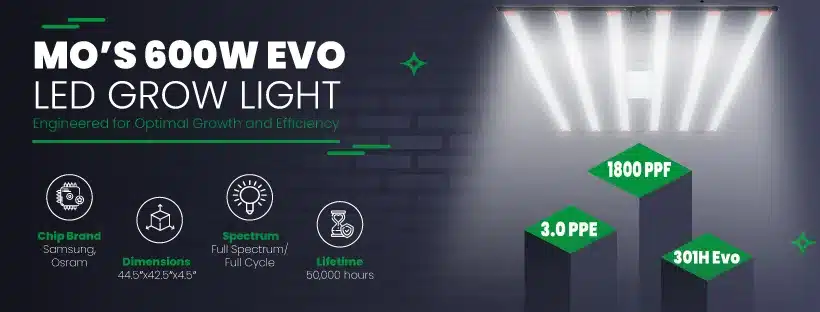Understanding the Spectrum: A Guide to Plant Pigments and Photoreceptors
In the complex world of specialty plant cultivation, understanding the interaction between light and plant physiology is crucial for optimizing growth conditions and achieving high yields. This guide delves into the vital roles of chlorophylls and carotenoids—key pigments in high-value plants—that harness and utilize light energy. By exploring their specific light absorption peaks and their implications in plant health, growers can tailor their lighting strategies to enhance plant growth effectively, leading to robust health and productivity under controlled environmental conditions.
Chlorophyll A in Specialty Plants
Absorption Peaks:
- 430 nm (Blue Spectrum): This wavelength is essential for the initiation and development phases of photosynthesis. The blue light is particularly significant in regulating various morphological and physiological processes in specialty plants, including leaf development, stem elongation inhibition, and the opening of stomata, which are critical for transpiration and gas exchange.
- 662 nm (Red Spectrum): Red light absorbed by Chlorophyll A is primarily responsible for driving the photosynthetic process. This light supports the synthesis of glucose from carbon dioxide and water, providing the energy required for the plant’s growth and flowering stages. Red light is crucial during the flowering phase of high-value plants, influencing flower formation and development.
Role in High-Value Plants: Chlorophyll A is the central pigment involved in the light-dependent reactions of photosynthesis. It captures light energy and converts it into chemical energy via the photosynthetic electron transport chain. This energy is then used to synthesize ATP and NADPH, which are vital for the Calvin cycle, thereby producing sugars that fuel plant growth and development.
Chlorophyll B in Specialty Plants
Absorption Peaks:
- 453 nm (Blue Spectrum): Chlorophyll B absorbs light at a slightly different peak in the blue spectrum compared to Chlorophyll A. This absorption enhances the range of light that specialty plants can utilize, improving the efficiency of photosynthesis, especially under lower light conditions or when light is partially shaded by other leaves.
- 642 nm (Red Spectrum): This peak is slightly shifted compared to Chlorophyll A and allows Chlorophyll B to capture additional light that Chlorophyll A does not absorb as effectively. This broadens the effective spectrum of light for energy capture, which is vital for optimizing photosynthetic activity throughout the plant.
Role in High-Value Plants: Chlorophyll B serves as an accessory pigment, supplementing Chlorophyll A. It helps in harvesting light at wavelengths that Chlorophyll A does not absorb efficiently, thereby expanding the spectral range of light that is useful for photosynthesis. Chlorophyll B can transfer the absorbed energy to Chlorophyll A, which then uses this energy to drive the primary reactions of photosynthesis. This synergy between Chlorophyll A and B is crucial for maximizing the photosynthetic capacity of high-value plants, particularly under varying lighting conditions, such as those experienced in indoor growing environments where artificial lights are used.
Importance in Specialty Plant Cultivation
Understanding the specific light absorption properties of Chlorophyll A and B is critical for specialty plant growers to optimize their lighting systems. By providing light that closely matches these absorption peaks, growers can enhance the efficiency of photosynthesis, leading to healthier plants and potentially higher yields. This knowledge guides the selection of grow lights and the scheduling of light exposure, ensuring that high-value plants receive the most beneficial light for their growth phase—whether vegetative or flowering.
Carotenoids in High-Value Plants: Beta-Carotene, Lutein, and Zeaxanthin
Absorption Peaks:
- 400-500 nm (Blue to Green Spectrum): This range is critical for absorbing light energy that is not as efficiently captured by chlorophyll. The absorption of light in this spectrum helps the plant utilize a broader range of the light spectrum available, particularly under intense lighting conditions where light not absorbed by chlorophyll would otherwise contribute to thermal stress.
Roles in Specialty Plants:
Beta-Carotene:
- Antioxidant Protection: Beta-Carotene is a potent antioxidant in the photosynthetic apparatus, protecting chlorophyll and other photosynthetic components from oxidative stress caused by high light conditions. This is critical in preventing the degradation of chlorophyll and other light-sensitive compounds that are essential for photosynthesis.
- Precursor to Vital Compounds: Although its role as a vitamin A precursor is more pronounced in animal systems, in plants, Beta-Carotene is crucial for the synthesis of various growth-regulating hormones and compounds that contribute to the overall health of the plant.
Lutein:
- Energy Transfer: Lutein is integral to the light-harvesting complex within chloroplasts, facilitating the transfer of energy to chlorophyll a. This energy is then used in the photosynthetic process to convert light energy into chemical energy.
- Protective Quenching: Lutein assists in quenching excess energy that can lead to photooxidative damage. This function is crucial under intense light exposure, helping to stabilize the photosynthetic machinery and ensuring sustained photosynthetic activity.
Zeaxanthin:
- Non-Photochemical Quenching: Zeaxanthin plays a vital role in non-photochemical quenching, a protective process where excess light energy is dissipated as heat. This is particularly important in conditions of excessive light intensity, preventing damage to the photosystems and supporting plant health under stress.
Importance in Specialty Plant Cultivation
The presence of carotenoids such as Beta-Carotene, Lutein, and Zeaxanthin is crucial for maintaining the integrity and efficiency of the photosynthetic systems in high-value plants. These pigments not only protect against photo-oxidative damage but also ensure that the energy from light is efficiently converted into chemical energy, crucial for plant growth and development. Their ability to protect the plant cells from oxidative stress helps maintain the overall health and productivity of specialty plants, especially under artificial lighting conditions that can vary in intensity and spectral quality.
Application in Grow Light Technology
For specialty plant growers, understanding the absorption spectrum of these carotenoids can guide the selection of grow lights that provide a balanced spectrum, covering not only the peaks necessary for chlorophyll absorption but also those that support the protective functions of carotenoids. Lights that include wavelengths in the blue to green spectrum can help ensure that these pigments function optimally, protecting the plant cells and enhancing photosynthetic efficiency.
Additional Carotenoids and Photoreceptors Relevant to Specialty Plant Cultivation
In order to optimize specialty plant cultivation, understanding the specific roles of various pigments and photoreceptors, particularly those involved in light absorption and protection against environmental stresses, is essential. Here, we will discuss additional key compounds including phytoene, phytofluene, violaxanthin, neoxanthin, anthocyanins, and flavonoids, as well as critical photoreceptors that regulate plant responses to light.
Carotenoids Specific to UV Protection
Phytoene
- Absorption: 286 nm (UV light)
- Role: Phytoene serves as a precursor in the biosynthesis of other carotenoids and plays a key role in protecting high-value plants from UV-induced damage by absorbing harmful UV rays. This protection is vital for maintaining cellular integrity, especially under conditions of high UV exposure.
Phytofluene
- Absorption: 348 nm (UV light)
- Role: Similar to phytoene, phytofluene helps shield plant cells from solar radiation. Its absorption of UV light reduces the damaging effects of UV stress, supporting overall plant health and vitality.
Xanthophylls in Light Harvesting and Protection
Violaxanthin and Neoxanthin
- Absorption: 400-500 nm (blue and green spectrum)
- Role: These xanthophylls are integral to the light-harvesting complexes and are active in the xanthophyll cycle. They play a crucial role in non-photochemical quenching, where they help dissipate excess light energy as heat, thus protecting the plant from photooxidative stress.
Anthocyanins and Flavonoids: Pigmentation and Protection
Anthocyanins
- Absorption: 520-700 nm (green to red spectrum)
- Role: Anthocyanins provide distinctive pigmentation, which can protect high-value plants from UV radiation and contribute to stress resistance. They enhance the visual appeal and may influence the perceived quality of specialty plants, particularly under lower light conditions.
Flavonoids
- Absorption: Primarily UV-B and blue light
- Role: Flavonoids offer additional UV protection and influence the coloration and flavor profile of high-value plants. They also enhance the plant’s resistance to diseases and pests.
Photoreceptors: Regulating Plant Growth and Development
Phytochromes
- Absorption: Red (660 nm) and far-red (730 nm) light
- Role: Phytochromes are critical in regulating various growth stages from seed germination to flowering. They detect the red to far-red light ratio, helping the plant adjust its growth in response to light quality and canopy density.
Cryptochromes
- Absorption: Blue (320-500 nm) and UV-A light
- Role: These blue light receptors are vital for regulating growth, circadian rhythms, and development. In high-value plants, they optimize responses to light, ensuring efficient growth under artificial lighting by enhancing blue light absorption, without the need for additional UV-A.
Phototropins
- Absorption: Blue light (350-450 nm)
- Role: Phototropins promote phototropism, helping specialty plants orient towards light. They also manage stomatal opening for optimal transpiration and gas exchange, critical under intensive cultivation lights.
UVR8 (UV Resistance Locus 8)
- Absorption: UV-B light (280-315 nm)
- Role: UVR8 mediates the plant’s response to UV-B, enhancing defense mechanisms against UV stress, which can include changes in growth patterns and activation of protective pathways.
Cultivation Implications
For specialty plant growers, the practical application of this knowledge involves selecting grow lights that adequately cover the necessary light spectra for optimizing both photosynthesis and protective mechanisms. While the focus should remain on robust coverage in the blue to red spectra, understanding the roles of these pigments and receptors ensures that growers can prevent stress responses and promote healthy plant development.
By leveraging grow lights that emphasize lower blue ranges (near UV-A), growers can achieve adequate protection and physiological benefits without the need for specific UVA supplementation, simplifying light management and reducing complexity in grow operations. This approach avoids unnecessary UVA additions, aligning with modern horticultural practices based on the latest scientific understanding.
Conclusion
Having explored the critical roles and optimal absorption ranges of chlorophyll and carotenoids, specialty plant cultivators are equipped with the knowledge to select grow lights that not only match these peaks but also support the plant’s overall photosynthetic and protective mechanisms. As we transition to discussing the practical applications of specialized lighting, such as far-red and UVB, understanding the foundational lighting requirements sets the stage for integrating advanced techniques that can further refine and enhance the growth process, ensuring that each plant reaches its full genetic potential covering both the potential benefits and downsides.


